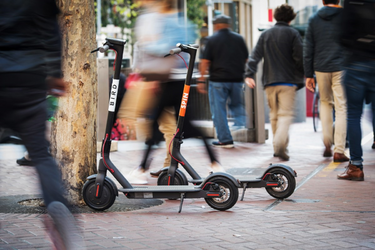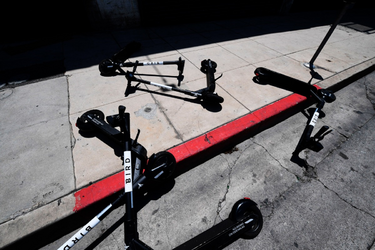
[Source Photo: Mario Tama/Getty Images]
It’s hard to overstate how brutal last December was for the shared e-scooter industry.
A quick rundown: First, in the middle of the month, news broke that Superpedestrian was shutting down just 18 months after raising $125 million in fresh funding. A few days later, Micromobility.com, formerly known as Helbiz, was delisted from Nasdaq for failing to maintain a share price above $1. Then came the biggest shockwave of all: Bird, the largest e-scooter company in the U.S. with a one-time valuation of $2.5 billion, filed for bankruptcy.
Such struggles will delight fans of Bird Graveyard, a popular Instagram account offering videos of people kicking over e-scooters and flinging them off buildings. Its 80,000 followers are hardly alone: E-scooters might be the most loathed mobility innovation of the 21st century. “If one of the casualties of the trade war [with China] is e-scooters, I have to admit I’m fine with that,” quipped comedian John Oliver in 2019.

[Photo: David Paul Morris/Bloomberg/Getty Images]
But those who care about the future of urban life should not indulge in scooter schadenfreude. For all the annoyance they inspire, shared e-scooters have been valuable additions to American neighborhoods, frequently replacing car trips that pose a much greater threat to street safety and clean air. Cities—whose leaders have contributed to e-scooters’ current predicament—would be worse without them.
Upon examination, many of the most common e-scooter complaints are actually indictments of bad street design. Yes, e-scooter users can startle pedestrians on the sidewalk, but that would happen less frequently if cities provided networks of protected bike lanes. Yes, e-scooters abandoned in the middle of footpaths obstruct those pushing a stroller or rolling along in a wheelchair—which is an excellent reason to install more bike corrals. And yes, it is stressful for drivers to see an e-scooter user dart in front of them, but, again, that wouldn’t occur so often if riders could use bike lanes that separate them from cars.
Sheer loathing can exaggerate perceptions of the danger posed by 45-pound vehicles whose speeds are capped below 15 miles per hour. In a 2019 column titled “Scooter Madness,” Margaret Renkl of The New York Times bemoaned scooters that were “wreaking havoc” on her native Nashville. Renkl demanded that city leaders act as a “safety-conscious parent,” either by enacting firm e-scooter regulations or banning them outright. One wonders what she thinks about SUVs that can be 150 times heavier and travel seven times as fast as e-scooters—and are orders of magnitude more likely to kill a bystander.
In my view, much of the hostility toward e-scooters relates to their unique form factor. Tara Goddard, an urban planning professor at Texas A&M, has found that people tend to identify with others who commute in the same manner (“drivers,” “cyclists,” etc.), forming alliances and identifying enemies as they compete for scarce road space. Unlike mobility innovations such as e-bikes and ridehail that resemble traditional bikes and cars, respectively, e-scooters look like unwelcome interlopers. (Ironically, popular pushback toward ridehail has been comparatively muted despite mountains of evidence showing that its toll on urban life is severe—especially when it comes to thickening congestion and shrinking transit ridership.)
As city transportation staffers will tell you, community complaints about e-scooters are vociferous and widespread. A couple of years ago, a Department of Transportation director of a large U.S. city told me that if his constituents could vote on whether to allow e-scooters, they would reject them. Last April, Paris held such a referendum: A whopping 89% of voters opted to boot the shared-scooter companies.
But that U.S. transportation director insisted to me that he, himself, was an e-scooter fan, referencing studies from places like Arlington, Virginia; Portland, Oregon; and Chicago, which found that a third to a half of e-scooter trips would have otherwise occurred in a car (the rest replaced walking, transit, or biking—or would not have happened). Cities receive a bounty of benefits whenever an e-scooter is used in lieu of an automobile: Emissions fall, roadway space is freed up, and other street users are placed in less danger.
In other words, shared e-scooters enhance urban efficiency, sustainability, and street safety. But many residents ignore these upsides, instead fixating on the irritation of encountering e-scooters while walking or driving.
Cognizant of residents’ resistance, many city officials have managed e-scooters with an iron hand. “Onerous regulations have been major problems for operators,” Ben Bear, who previously ran Spin, an e-scooter company acquired by Bird last September, told me over the holidays.
Dubious e-scooter rules can take various forms. Many cities strictly limit the number of permitted vehicles, frustrating riders and reducing companies’ revenues. In some places riders must affix e-scooters to a fixed object on the street, even if there is a dearth of bike corrals; in others they must park in specific zones that may be blocks away from an origin or destination. Certain cities, like Chicago, demand that e-scooter companies accept liability even for crashes caused by potholes. To ensure e-scooter access in low-income communities, operators are frequently required to rebalance charged e-scooters by moving them to new locations where trip demand may be lower.
Of course, equity and street safety are crucial goals, but shared e-scooter companies help achieve them simply by being a viable alternative to cars, which are much more expensive and deadly. Placing heavy requirements on e-scooter operators can do more harm than good, potentially driving them out of markets entirely. December’s drumbeat of bad news showed that the days of limitless venture capital dollars are long over for the e-scooter industry. If anything, cities wishing to retain e-scooter access should at a minimum reconsider onerous regulations. They might even need to offer financial support, as a growing number now do with bikeshare.
“Just like with transit, subsidies are needed for e-scooters to be viable,” Bear says. “Otherwise it doesn’t pencil in most places.” The idea of taxpayers helping to fund private e-scooter services may seem shocking, but it shouldn’t. All transportation modes are subsidized, from the free parking offered to car owners to the federal funds allocated toward public transportation. Why, exactly, should shared e-scooters be different?

[Photo: Robyn Beck/AFP/Getty Images]
To be fair, all blame for e-scooter struggles can’t be placed on overzealous public oversight. Some of the industry’s challenges are of its own making, including initial attempts to arrive in new markets en masse and uninvited, emulating ridehail’s expansion strategy of asking cities for forgiveness rather than permission. Bird even hired Bradley Tusk, a consultant who helped orchestrate Uber’s combative approach toward government relations.
“That was a fundamental miscalculation,” Bear says. “Unlike with [ridehail], where you have private cars driven by individual drivers, it was very easy for cities to pick up scooters and impound them because they were in the right of way.” Those early regulatory fights seeded distrust between scooter companies and city halls that lingers to this day.
Even if cities and e-scooter companies had given one another everything they wanted, some degree of market consolidation was inevitable, as happened with ridehail in the early 2010s and with the nascent car industry a century earlier. And cratering trip demand during COVID-19, along with the subsequent rise in interest rates, would have created potent headwinds no matter what (Bird’s ridership collapsed 50% in 2020). With e-scooter companies already facing so many challenges, burdensome local regulations have made viability that much more elusive.
Looking ahead, surviving e-scooter operators such as Lime, an e-scooter heavyweight founded in 2017, may find an easier pathway toward stabilization. (As a private company, Lime is not obligated to release financial information, but it claims to already be profitable). But they, too, are vulnerable to the same pressures that have doomed their competitors.
It is entirely plausible that many communities full of e-scooters just a few months ago will soon see them completely disappear. If so, American cities will become more dangerous, polluted, and congested. No one should be rooting for that to happen.
Article Link
Archive